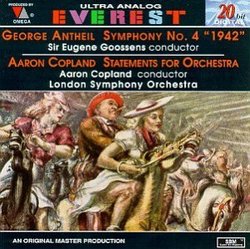Sonic spectacular, but musically Copland way above Antheil.
Discophage | France | 06/19/2008
(4 out of 5 stars)
"I already had George Antheil's 4th Symphony, on its previous CD reissue on Bay Cities, paired there with Morton Gould's superb Spirituals for orchestra, superbly conducted by Walter Süsskind (see my review, George Antheil ~ Symphony 4 / Morton Gould ~ Spirituals for Orchestra). But I've heard a few of these Everest reissues and they were sonic spectaculars (for instance Villa Lobos: The Little Train of the Caipira; Antill: Corroboree; Ginastera: Estancia; Panambi), so I decided to try this one, which afforded the additional bonus of Aaron Copland's first recording of his impressive "Statements", from 1958 (he made a more easily accessible remake for Columbia - now Sony -, with the same orchestra and in the same recording venue, in 1965, now on The Copland Collection: Early Orchestral Works, 1922-1935).
The sonics of the Antheil/Bay Cities were already impressive. On the Everest reissue, they are even better: more sonic width and depth, less tape hiss. That said, the improvement didn't help much to improve my (lack of) appreciation of the composition. I am very enthusiastic for the young, firebrand Antheil from the 1920s, the imitator of the radical Stravinsky (Le Sacre, Les Noces) but who managed to out-do his idol in radicalism and daringness (see my numerous reviews, for instance George Antheil: Bad Boy's Piano Music, Piano Pictures: Satie Sports & Divertissements / Antheil La Femme 100, George Antheil: Violin Sonatas 1, 2 & 4). The 4th Symphony is a later work (1943), and was an important milestone in Antheil's career, pulling him out of a very low ebb. Some 15 years after the infamous Carnegie Hall concert ("event" would be a better term) with his Ballet Mécanique which had durably molested his reputation in the US, Antheil was stranded in Hollywood, writing off and on film music which he himself considered trite, authoring improbable newspaper columns on endoctrinology and war strategies, devising short-lived schemes supposed to bring him fortunes, including a patent for a torpedo radio-control system with actress Hedy Lamar, dabbling at this and that, unable to focus. The Symphony was inspired by the turning tides of World War II signalled by the British victory at El-Alamein. Its composition developed as the war progressed, and its music mirrors the events. By early 1943 it was finished, Stokowski (who almost premiered the composer's First Symphony in 1920) accepted it with no delay, and gave it its broadcast premiere with the NBC Symphony Orchestra, on February 13, 1944, to great success (that performance can be found on Ralph Vaughan Williams: Symphony No.4 in f minor / George Antheil: Symphony No.4).
The symphony is expertly orchestrated, and, especially in the second and third movement (and at 4:29 into the finale), one hears that Antheil has carefully studied the symphonies of Mahler (not so common maybe in those pre-1950 years) and especially the Resurrection (is it because it was the only one prior to 1944 to have had an accessible commercial recording?), but maybe not entirely digested the influence (a feature even more in evidence with the Sibelius influences in the 3rd Symphony, see my review of George Antheil: Symphony No. 3 "American"). But when I say that the music mirrors the events of the war, it is exactly that: it is a collection of bombastic marches: heroic marches, mischievous marches, ominous marches, threatening marches, triumphant marches, evoking less Shostakovich (the similitude of late Antheil with Shostakovich and the late Prokofiev has often been noted) than Myaskovsky.
Aaron Copland's Statements is something else. I am one to lament Copland's turn to a more "popular" vein - not only do I have no particular taste for it, but moreover, though I've never crossed any comments to that effect, when I read what Copland said about the switch (the need for public success), it strikes me as a severe case of pandering to the public's taste and, ultimately, I can't escape the conclusion that it shows a certain lack of artistic integrity. But things weren't as clear-cut as "once a radical, turned a populist": Copland never abandoned his more severe style - witness his Piano Sonata, begun in 1939 just after the completion of Billy the Kid, the 1957 Piano Fantasy or the 1962 Connotations for Orchestra.
Statements was composed between 1933 and 1935 and consists of six short and (except for the fifth, Jingo, a boisterous Stravinskian-Cubist circus music) terse movements, with granitic themes and orchestration. It is superb. Sonically and interpretively, there is little to choose between Copland's two recordings. There may be slightly more width in the later one from Columbia/Sony, but slightly more instrumental alacrity in the earlier one, which also has marginally more bite in the fast movements, but slighly less tension (and a more spacious tempo) in the slow movement for strings alone (4th movement, "Subjective").
So the potential buyer is left with a difficult choice. For Antheil, Bay Cities or Everest? As mentioned, sonics are marginally better in the latter but they are already very good in the former, the Bay Cities Morton Gould fillers are fine and I wouldn't want to be without Süsskind's Spirituals (better than Hanson's, Gould: Spirituals; Fall River Legend Suite; Barber: Medea Suite) - but it can be found on another Everest CD (with Copland's Appalachian Springs and Gershwin's American in Paris): Copland: Appalachian Spring; Gould Spirituals; Gershwin: An American in Paris. But the ultimate deciding factor may be total timing: 68+ minutes on Bay Cities against an un-generous 49:41 here. For Copland, the Sony Copland Collection is very practical. So, ultimately, this Everest must probably be reserved to the collectors, not shy of duplications.
"


 Track Listings (10) - Disc #1
Track Listings (10) - Disc #1